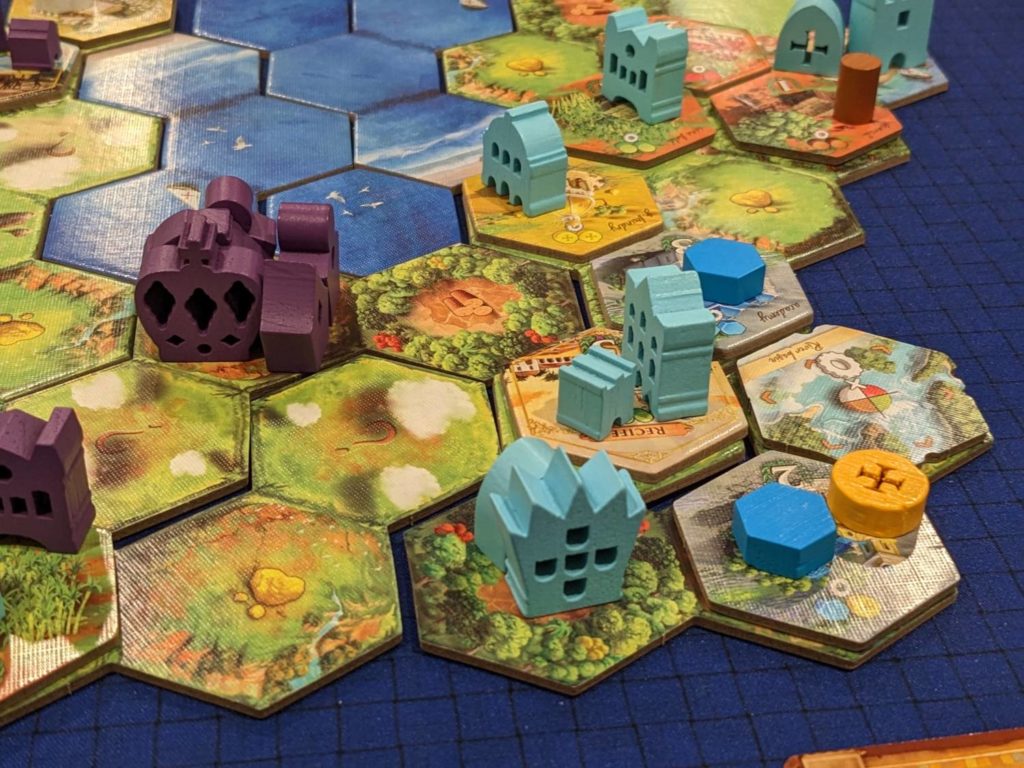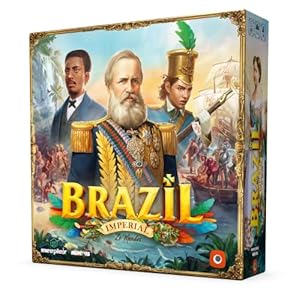Disclosure: Meeple Mountain received a free copy of this product in exchange for an honest, unbiased review. This review is not intended to be an endorsement.
Scythe. Scythe. Scythe.
I love the game Scythe. I love playing it at all player counts. Heck, I love it so much that when I first bought the game in 2017, I played it solo when solo play was completely unheard of in my house. Scythe is an incredible production—my first Stonemaier game—and it is so rich with strategic options based on the asymmetry of the available factions.
The Scythe player mats were one of my first experiences with a dual-layer board that was all mine. Those mechs, the public scoring mechanic tied to popularity, the way bonuses might trigger when a neighbor took actions, the concept that combat was sometimes a threat, and other times combat was a massive ball fake. All of this came together so well with the world building; the artwork, that striking cover image on the box, the flavor text for the encounter and objective cards.
Scythe is so good! The only reason I don’t have my copy any more is that my gaming circles have moved on. Playing the base game 50+ times (between the physical and the digital version), then playing expansion content, then doing the legacy campaign The Rise of Fenris…even I had to admit I was Scythe-d out by the time COVID arrived.
But I still love “4X” games, especially if they can be played in two hours or less. When a review copy of the new 4X game Brazil: Imperial (2022, Portal Games) came available, I was all over that like white on rice.
While I’ve enjoyed Brazil: Imperial, each play has ended with someone saying the same thing:
“That was fun. Do you think we have time to get in a quick game of Scythe?”

4X 101
Brazil: Imperial plays like Scythe in so many ways that it is safe to assume designer Zé Mendes is at least aware of Scythe’s existence.
Taking on the role of an empire attempting to eXpand in the New World, players take turns completing one of the game’s seven different actions to score the most victory points across three eras. Like eXpand, the other Xs are in play here: you’ll need to eXplore undiscovered parts of the game’s map, scaled to player count. You’ll have to eXploit different terrain types by building production buildings and cities, granting you resources and assets.
And, you’ll have to eXterminate opposing units. Well, sometimes. Actually, not often, particularly at higher player counts. Units are deployed once (just like, yep, Scythe), and when they are defeated, they can respawn at another city or starting palace location as soon as your next turn.
Combat is Brazil: Imperial’s only major weak spot. In fact, I think combat is also the only weak spot of Scythe, although at least combat (even the threat of combat) is interesting in Scythe. Just know that if you were hoping for a 4X game that highlighted combat as its strength, Brazil: Imperial won’t be your jam.
The other Xs shine thanks to the mechanics that parallel the strengths of games like Eclipse: Second Dawn for the Galaxy and what I saw during my demo experience with Voidfall, the 4X game coming soon from Mindclash Games. In Brazil: Imperial, this starts with the Arch Action system.
There are seven actions: Deploy, Painting, Build, Renovate, Manufacture, Trade, and Harbor. The Trade and Harbor actions are easy: players get one or more resources (brazilwood, sugarcane, cotton, and coffee beans) or assets (gold and science, as well as gold cards) from the supply.

The other actions are incredibly straightforward. Deploy gets your military units on the map, although that action does not move units; we’ll come back to moving units later. Paintings can be bought from a small market, granting one-time bonuses or ongoing powers, as well as VPs. Build is used to place more building tiles on the map. Based on the current era, you can build farms, sawmills, gold foundries, cities, churches, and more. Players can Renovate their buildings to flip them over and provide access to different resources/assets.
Manufacture makes every other action more efficient. Spend resources/assets to add a wooden component to make one of your actions a little juicier, and you can do that as soon as the second turn of the game.
Like Scythe—there’s that game again!—you have to select a different action in each turn of Brazil: Imperial. Like Scythe, turns are super fast. Like Scythe, buildings produce resources on the map during the Build/Renovate actions, making them available to the current building owner right away (and making them a target for opposing players to raid). Like Scythe’s encounter tokens, the map of Brazil: Imperial has “Exploration” tiles that can be discovered by your lead military unit, known as the Monarch. Those Exploration tiles have treasures, potential one-time bonuses, or a set collection scoring element for VPs.
Before play begins, each player is given Era mission cards that drive their objectives. When a player completes their Era 1 mission, the game pauses. That player gets to place a scoring building—a palace—on the map, while all players get to remove their action marker. This means that on their next turn, they could take any action, including the action they just took. New Eras mean access to better buildings for all players.
When any player finishes their Era III mission card, that round becomes the final round of the game to ensure all players get equal turns. Scoring is a mishmash: deployed units, manufactured products, palace scoring, city and building scoring, painting scoring, Gold cards, Exploration tiles, Era missions. It’s all a little messy at first, but after a few plays things become clearer, ensuring you can “guesstimate” when it might pay to speed the ending because one of your neighbors is loading up for a big scoring round soon.

Slick, With Some Caveats
I’ve played Brazil: Imperial four times: once each at solo, two, three, and four players. The Arch Action system was a hit with everyone who tried the game. It’s very intuitive, and the actions are incredibly easy to teach. Brazil: Imperial’s only complication—and even then, it’s light—is the movement system, which breaks away from other 4X games I’ve highlighted in this article. Players can move a deployed military unit one hex for free at the end of every turn, and maybe a second unit (or to a second hex) based on the chosen Arch Action’s movement terrain type.
Some games have a market/trade option that, frankly, sucks. Not so in Brazil: Imperial. In fact, with each successive play, I used the Harbor and Trade actions more often, because getting stuff is so easy and so flexible. This is one of my complaints about all resource-heavy games such as Fantastic Factories: at some point, you’re going to have a lot of energy and nowhere to use it. In Brazil: Imperial, you’ll always be able to use the items your buildings produce.
In Brazil: Imperial, victory points equal strength. It’s that simple. If the Dutch Empire deploys its Cannon unit, it will show under its space that the Cannon is worth five points at the end of play. It is also worth five combat points during a fight. When you visit an Exploration tile, any of these tiles that are Expeditions (mini fights against a discovered tile, not another player) show a number of victory points. That’s also the amount of combat points you’ll need to win that fight, and the number of points you’ll earn at the end of the game if you defeat that Expedition.
I don’t think I have ever seen VPs used this way in a game, and this is another reason why Brazil: Imperial is so easy to get to the table. This is also why I’ll take Brazil: Imperial over games like Eclipse: Second Dawn for the Galaxy. I love a good space opera, but do I really have an hour to teach then four hours to play Eclipse with six players?
There are a few negatives with Brazil: Imperial. First and foremost is the lack of variety in card choice. There are only 24 paintings in the game. There should be at least double that. There are only 24 Era cards to choose from, eight for each Era. By my third game, I had seen every single Era card Brazil: Imperial had to offer.
I also hoped for more excitement with the player powers. There are four player boards, and there is a double-sided tile available for each of the game’s four colors (Brazil’s board has two of these tiles, so you have four player power choices instead of two). The “powers” are often quite bland; both powers for the Dutch are essentially “get one extra gold and one extra point for your first three sawmills.”

Game-breaking player powers, these are not. Those hoping for anything like the powers in 4X games such as Twilight Imperium or Civilization: A New Dawn are not going to love the variety in Brazil: Imperial.
Solo is only OK. You get 20 turns to trigger the third Era and defeat the automa faction’s capital (you aren’t allowed to attack capital cities in multiplayer games). On my very first try (before even trying multiplayer!), I beat the solo in 19 turns. I like that the solo is not ridiculously hard, but I wish solo play was a little more interesting.
I also wish solo played like a normal game. And that is to say that combat is generally unlikely.
Brazil: Imperial is fascinating in a way that I can’t quite categorize. If you play it solo or at two players, it is a battle royale. The maps will be tiny and you are going to be forced into combat. If you play this game at three or four players, it’s a Euro efficiency game, and you may not trigger a single combat during the entire game, at least not any combat of consequence. (In my three-player experience, there wasn’t a single combat in the entire game!)
This means I can’t play Brazil: Imperial with my wife. She hates direct combat games and when she sniffs one out, she always refuses to try one. Many of my heavy strategy gaming friends like a good battler, but at four players, the chances of achieving battle here are low. Even the manual highlights the “Chance of Combat” for each variable map setup, and all of the included two-player versions are rated 3 out of 3 (high chance). All of the three/four-player maps are rated 1 or 2 out of 3.
Weird, right? In Eclipse, Scythe, and other 4X games, there’s usually something sitting in the middle of the map that is worth fighting for, such as the Foundry in Scythe that provides a fifth action for any player who visits. Maybe Brazil: Imperial needs something like this to increase the chance of combat for larger player counts.
One last thing, and this one is minor. I wish Brazil: Imperial shipped with recessed spaces for the vast array of components that reside on the player boards. The boards are thick, but they don’t have the indentations needed to keep all 16 wooden pieces in place. Sounds like a quibble, but it is so satisfying to move cubes around on the Scythe player mats, or around the spots on player trays with the second edition of Ecilpse. I’m sure this would drive the price up, but the rest of the production is so great in Brazil: Imperial that I wish this had been considered.

4X Rookie Delight
I really enjoyed Brazil: Imperial. It plays quite differently based on the player count—sometimes a combat-heavy duel, other times a combat-free sprint—so that is what gives it variety from play to play. Turns are quick, games typically take 90 minutes, and it’s not a bear to teach. It gets a lot of little touches right, like including a historical overview manual included with the game.
Brazil: Imperial will land best for those looking for a midweight experience. I already know that my heavy strategy group won’t enjoy this game as much as I do.
I’m worried about a few things with Brazil: Imperial, mainly the somewhat scripted opening approach. During each of my plays, someone built a sugarcane building with their first action using a starting resource, then used the two resources produced on that tile to take the Manufacture action to place a cube on the Harbor action, then used the Harbor action to take a resource and a Gold card. Gold cards can be used as either gold, extra actions, or end-game scoring opportunities.
Shouldn’t each player start with more resources? Also, the lack of variety in Era missions means that you are probably attacking the game the same way each time out, and none of the mission cards require wins in combat, another sign that the game is leaning away from forcing combat on players. That’s fine, but I think it will blunt some of the creativity in approach after your fifth or sixth play.
Brazil: Imperial needs expansion content, and one would assume that is inbound in the months ahead. But this is a fantastic start, and I’m excited to keep this one in my collection!












Add Comment